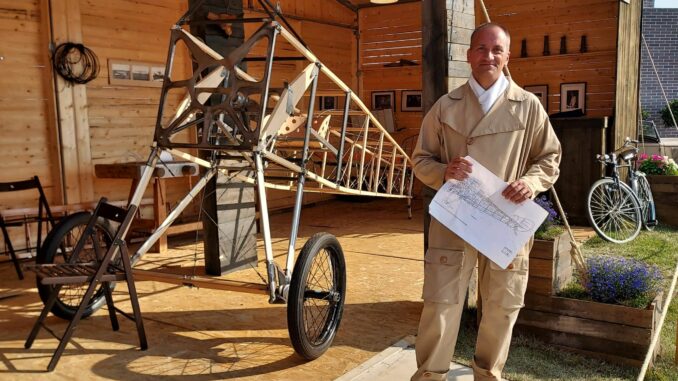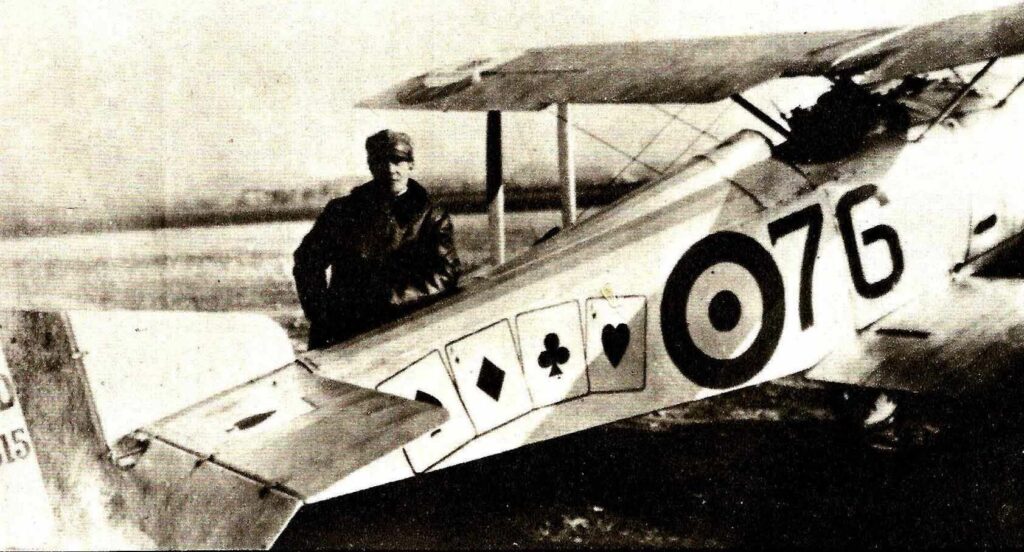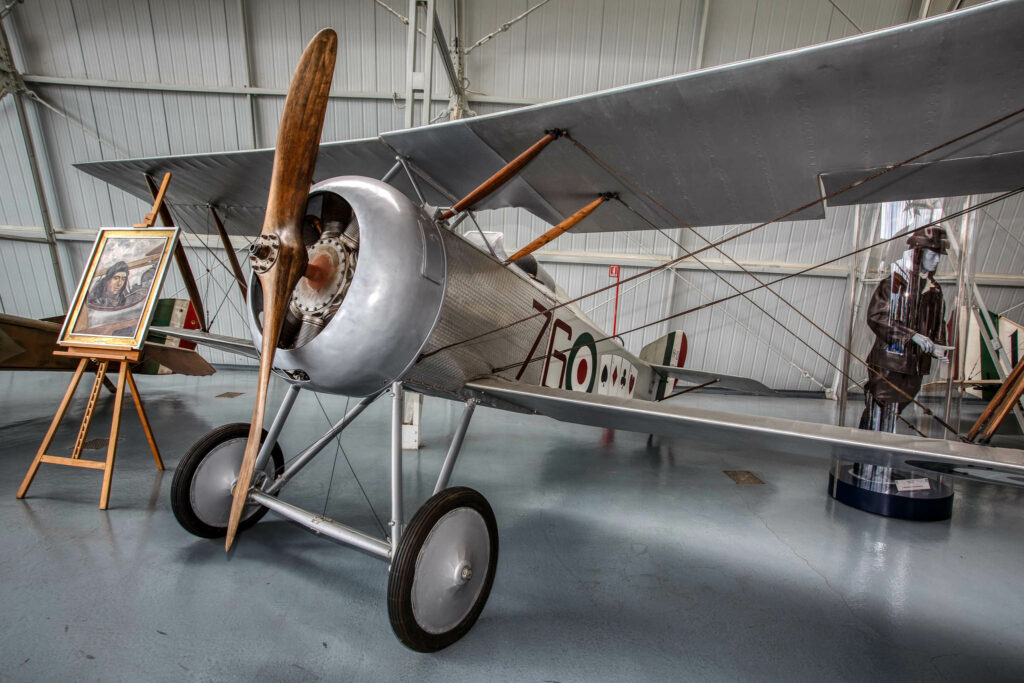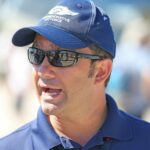
Ermete Grillo, originally from Rome but now resident in Pisa, Italy, is on a mission: to create a perfect reproduction of the Hanriot HD.1, as flown by ace Flavio Torello Baracchini, who claimed 31 victories in only six months of the Great War.
“I don’t remember a day in my life that I didn’t spend scanning the sky dreaming of flying. I have always had a passion for flying since I was very young and after reading ‘Biplane’ by Richard Bach, I understood that in life I would have to do the impossible to own a Biplane.” said Ermete. “In 2004 I received the registration for my first homebuilt ultralight and in 2007, after years spent building it, I tested the biplane with which I currently still fly”.
As the President of the Biplano Club Italia (Italian Biplane Club), Ermete has had many opportunities to organize rallies and re-enactment flights. Today he is the President of the newly formed association ‘Le Ali degli Assi’ (ETS, Wings of Aces), a non-profit association committed to the preservation, restoration, and promotion of aeronautical culture linked to the pioneering period of flight.

The idea of building a fighter from the Great War has always been in Ermete’s mind. He had already purchased construction plans for the Nieuport 17 but, one day, in a bookshop, he found a book on the life story of a pilot previously unknown to him: Flavio Torello Baracchini. This book changed Ermete’s life. He discovered the existence of the ‘Caccia Macchi’, the ‘Macchi Fighter’, or license-built Hanriot HD.1 and how much it was appreciated by Italian pilots. After various vicissitudes, he managed to obtain the original construction plans drawn up by the then Societa’ Anonima Nieuport and Macchi di Varese. At this point, he had to decide whether to commit to the construction of (yet another) Nieuport, or dedicate himself to the flying reproduction of a fighter as rare as it is appreciated: the HD.1.
Why Baracchini?
Obviously, a key reason for spending thousands of hours in recreating an HD.1 is to commemorate the pilot who, more than any other Italian airman, showed how effective a fighter the Hanriot could be: pilot Captain Flavio Torello Baracchini. Italy’s greatest ace of WWI was Francesco Baracca with 34 aerial victories in three years of combat. In comparison, Baracchini shot down 31 aircraft in just six months!
Baracchini was the first Italian pilot in the history of aerial combat to be awarded the ‘Medaglia d’oro al valor militare’ (MOVM, the Gold Medal of Honor for Military Valor, Italy’s most important military honor). Baracchini, of humble origins, always placed the defense of his homeland before personal safety. His courage, and great humanity, were an example for all the other pilots, but above all, for the thousands of infantrymen who fought the harsh trench warfare below him. After the war Baracchini worked as an inventor, working in the areas of aviation communications and explosives. He died in 1928 as a result of injuries that he received during an accident in his laboratory.
The ‘HD.1 Baracchini Project‘ aims to rescue the ingenuity and construction techniques of the early 1900s from oblivion, but also to prevent this brave soldier from ‘dying a second time’ by preventing him from being forgotten.

The airplane
The fighter under construction is a Hanriot HD.1. Ermete has well-founded views and opinions about some of the historical assessments published on this WWI fighter: “First of all, I strongly want to deny what is often written on the web or in monographs … which is that the HD.1 was rejected by the French Air Force and then passed on to the Italians and Belgians: nothing could be more wrong! The HD.1 was created following a specific request from the Italian Aeronautical Commission in Paris which announced a competition for the purchase of a fighter with performances that could better adapt to the Italian operational context, which is very different from the French one. The pen of engineer Emile Dupont, who at the time worked for the French company Hanriot, satisfied the needs of Italian military pilots. 1562 examples of this fighter were produced, of which 991 by Macchi of Varese. The main users were the Italians and the Belgians, several examples were delivered to the Americans, a few to the French and the Swiss.”

The Hanriot HD.1 was a single-seat, single-engine biplane fighter. The double-spar biplane wooden wings feature a distinctive positive dihedral on the upper wings only, distinguishing it from the similar looking Sopwith Pup. The upper wings also include the ailerons. The fuselage, an almost entirely wooden structure, has the period-standard fabric covering aft of the third fuselage frame, with sheet metal cladding forward. The armament is a 7.7 mm (.303in) Vickers machine gun synchronized for firing through the propeller disc. The HD.1 type is powered by the Le Rhône 9J, a 110 – 120 hp nine-cylinder rotary engine. In Italian (and Belgian) combat use, the Hanriot which proved to be very robust and extremely agile fighter.
The first Italian squadron to receive the new fighter, in the summer of 1917, was 76a Squadriglia and subsequently 79a Squadriglia of the Italian Army’s Corpo Aeronautico Militare (Military Aviation Corps). With the pilots liking the biplane in the type of war they were fighting, Macchi received further orders to build more. In February 1918, out of 240 aircraft that the Fighter Squadrons were equipped with, almost half of them were Hanriots (103, of which 26 were not serviceable). In total, 1,700 HD.1s were ordered, of which 831 aircraft were delivered before the armistice and another 70 after the cessation of hostilities. The HD.1 remained in post-war service for several years, in Swiss, Belgian and even American service as well as with Italy. Today, only five original examples survive, with one airworthy in New Zealand.
Reconstruction process.
The reconstruction process started with the original 1917 plans by Aeronautica Macchi. Ermete said: “Since it is a reproduction, the aircraft being created could be perfectly matched to an original. By ‘reproduction of the aircraft’, we mean a way of working that enhances and favors the cognitive, technical, and preliminary investigation aspects, and involving a wide spectrum of skills required. The instrumentation is original from 1917, and, in order to guarantee a high degree of fidelity to what was produced in the early 1900s, it was decided to reproduce the correct, specific period wheel rims and rigging turnbuckles (out of production for 100 years!) as planned. Even the joins of the fuselage longerons have been made using a joint that is now obsolete, but required to be faithful to the project. What will make this unique in Italy, is that it will be a flying aircraft with a rotary engine; the original Le Rhône 9Jb. This engine, owned by the Il Magnete Association, will be loaned to project for use in flight. The completion of this project, therefore, has an intrinsic historical and cultural value aimed at maintaining and promoting construction and operational techniques that are now obsolete and which the passage of time otherwise inexorably consigns to oblivion.”
So far, two wing panels have been completed, with a third in the works; the tail surfaces; main landing gear; the fuselage frame and distinctive Hanriot cabane struts. Furthermore, almost all of the required period, original instruments have been found. Each phase of construction has been documented, and is the result of long and complex research, including the study of original technical materials such as construction plans and photographs. It should be noted as well that the reproduction of a historic aircraft necessarily involves the procurement and restoration of original components, increasing the authenticity and originality of the aircraft. Ermete’s work is monitored by the Club Aviazione Popolare (CAP), the only body delegated by ENAC (the Italian civil aviation authority) to oversee homebuilt projects in Italy. ENAC has already issued the registration; I-FTBA, with the tribute meaning (Flavio Torello BAracchini, with the I for Italian national listing).
Currently, the third wing is to be completed, with the fourth still to be built. Then, all the rigging and cables relating to the flying controls are still to be created. Other remaining tasks are the construction of the oil and gasoline tanks, sheet metal cladding for the front of the fuselage; framing, painting, and construction of the wooden propeller. The engine, which has been static for a century, will undergo a complete overhaul.

“Among the future objectives we set ourselves, are those of preserving, and disseminating the historical heritage of our aviation – by participating in national and international air displays and historical re-enactments. We also intend to create, on a specially dedicated airfield, a museum and cultural meeting place where the airplane can be operated from regularly. Furthermore we intend to achieve the publication of a book documenting the various phases of construction, as well as the construction techniques and materials used in the early 1900s”, concluded Ermete.
Ermete’s can certainly be seen as work is of top quality, and one can only feel a sense of admiration for the dedication, passion, and time dedicated to the reconstruction of a piece of aviation history. Vintage Aviation News will follow this fantastic project closely and we will keep our readers updated with the latest developments. If you wish to support Ermete and his work, click HERE.
Born in Milan, Italy, Moreno moved to the U.S. in 1999 to pursue a career as a commercial pilot. His aviation passion began early, inspired by his uncle, an F-104 Starfighter Crew Chief, and his father, a military traffic controller. Childhood adventures included camping outside military bases and watching planes at Aeroporto Linate. In 1999, he relocated to Atlanta, Georgia, to obtain his commercial pilot license, a move that became permanent. With 24 years in the U.S., he now flies full-time for a Part 91 business aviation company in Atlanta. He is actively involved with the Commemorative Air Force, the D-Day Squadron, and other aviation organizations. He enjoys life with his supportive wife and three wonderful children.







Be the first to comment
Graphic Design, Branding and Aviation Art